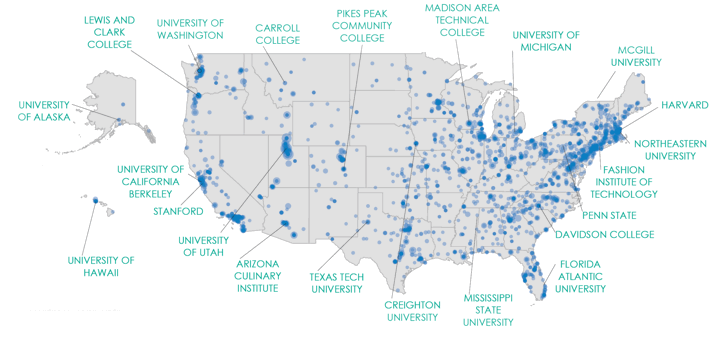
My quarterly statement told me that the My529 plan (formerly Utah Educational Savings Plan) has been around for 25 years now, and included the map above which has dots from all the different places that they have directly sent withdrawals. All 50 states are covered. This is good reminder to examine the flexible options that 529 plans provide, many of which were added relatively recently:
- Save and invest using the 529 plan custodian from any state. You don’t need to use the 529 plan from your home state (although you might get a tax break if you do – see below).
- Easy to accept outside gifts directly into your 529 balance. Just as people like to use gift cards instead of cash, it can be easier to ask for a gift directly to your child’s 529 plan instead of the latest YouTube-fueled toy. You can often just send a link and the money goes directly into your 529.
- Many investment options. You can choose an auto-pilot investment similar to a target-date fund (TDF), or you can mange your own glide path using a mix of active and/or passive index mutual funds. You can even stay super-conservative and invest in stable value funds or bank CDs.
- Spend in any state. You don’t need to use the money towards a college in your home state.
- Spend at a variety of educational options. 529 funds can be used at universities, colleges, certain overseas/international programs, trade and technical schools, apprenticeships, continuing education for adults, or K-12 private tuition.
- Spend beyond tuition. 529 funds can be used toward room, board, fees, books, computers, supplies and equipment that are required by those educational institutions.
- Scholarship exemption. If you end up receiving a scholarship, you can withdraw that amount from the 529 without paying the 10% penalty (normal income taxes on gains will still apply if not used towards qualified educational expenses).
- Spend on student loans. 529 funds can be used toward the principal or interest on qualified student loans (up to $10,000 lifetime maximum for the designated beneficiary and each of their siblings).
- Change beneficiaries. You can easily transfer 529 funds to another beneficiary, for example a sibling, nephew/niece, or even yourself. You can transfer funds from one 529 custodian to another.
- Save for the next generation. With any leftover amount, you can even change the beneficiary to the next generation (grandchild), although it would be considered a gift for tax purposes. Still, even a small upfront gift can to a big number if left to grow for decades.
My eldest child is 8 years old, so that means I’ve been contributing to her 529 plan for 8 years, and she’ll be making withdrawals in perhaps only 10 more years! Many fintech startups are offering custodial brokerage accounts now, and while I do think there is a teaching opportunity there when she’s a teenager, until then I only plan on funding the 529 account. The investments grow tax-free, adjust automatically with age, don’t create any tax reporting hassles, and are flexible enough for my expectations. By starting early, the tax-free growth benefit can potentially save thousands of dollars in taxes.
More 529-related posts:
 The Best Credit Card Bonus Offers – 2025
The Best Credit Card Bonus Offers – 2025 Big List of Free Stocks from Brokerage Apps
Big List of Free Stocks from Brokerage Apps Best Interest Rates on Cash - 2025
Best Interest Rates on Cash - 2025 Free Credit Scores x 3 + Free Credit Monitoring
Free Credit Scores x 3 + Free Credit Monitoring Best No Fee 0% APR Balance Transfer Offers
Best No Fee 0% APR Balance Transfer Offers Little-Known Cellular Data Plans That Can Save Big Money
Little-Known Cellular Data Plans That Can Save Big Money How To Haggle Your Cable or Direct TV Bill
How To Haggle Your Cable or Direct TV Bill Big List of Free Consumer Data Reports (Credit, Rent, Work)
Big List of Free Consumer Data Reports (Credit, Rent, Work)
Newbie here, I was told if 529 need to be listed on the college application and will be seen as a negative point for any potential scholarships that the child may be eligible for. I appreciate any input on this
529 balances are considered an asset of the parent, so it is the same as if you had the money in your own bank account or brokerage account. If a parent has a large amount of assets, then that will affect need-based financial aid obviously, but a 529 is no worse than any other parental asset, and it comes with tax benefits possibly at contribution and tax-free growth when used toward eligible educational expenses.